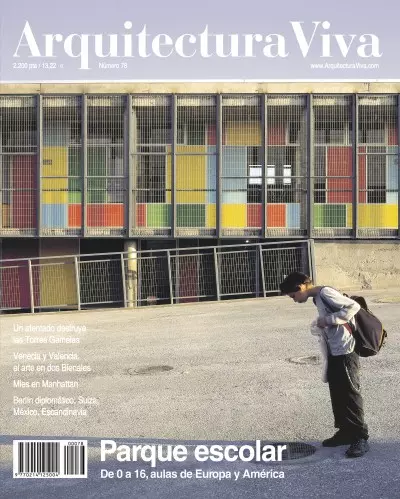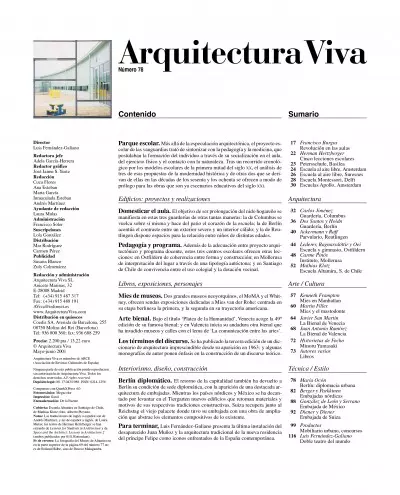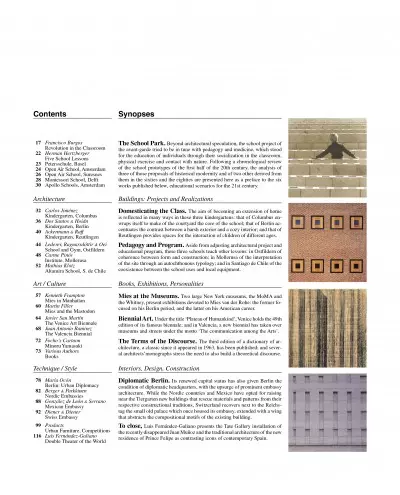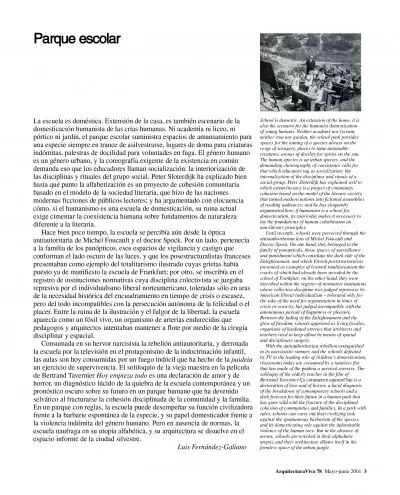Contents
The School Park. Beyond architectural speculation, the school project of the avant-garde tried to be in tune with pedagogy and medicine, which stood for the education of individuals through their socialization in the classroom, physical exercise and contact with nature. Following a chronological review of the school prototypes of the first half of the 20th century, the analysis of three of those proposals of historical modernity and of two other derived from them in the sixties and the eighties are presented here as a preface to the six works published below, educational scenarios for the 21st century.
Synopses
Francisco Burgos
Revolution in the Classroom
Herman Hertzberger
Five School Lessons
Petersschule, Basel
Open Air School, Amsterdam
Open Air School, Suresnes
Montessori School, Delft
Apollo Schools, Amsterdam
Buildings: Projects and Realizations
Domesticating the Class. The aim of becoming an extension of home is reflected in many ways in these three kindergartens: that of Columbus enwraps itself to make of the courtyard the core of the school; that of Berlin accentuates the contrast between a harsh exterior and a cozy interior; and that of Reutlingen provides spaces for the interaction of children of different ages.
Architecture
Carlos Jiménez
Kindergarten, Columbus
Dos Santos & Hoidn
Kindergarten, Berlín
Ackermann y Raff
Kindergarten, Reutlingen
Pedagogy and Program. Aside from adjusting architectural project and educational program, these three schools teach other lessons: in Ostfildern of coherence between form and construction; in Mollerusa of the interpretation of the site through an autochthonous typology; and in Santiago de Chile of the coexistence between the school uses and local equipment. Lederer, Ragnarsdóttir & Oei
School and Gym, Ostfildern
Carme Pinós
Institute, Mollerusa
Mathias Klotz
Altamira School, Santiago de Chile
Books, Exhibitions, Personalities
Mies at the Museums. Two large New York museums, the MoMA and the Whitney, present exhibitions devoted to Mies van der Rohe: the former focused on his Berlin period, and the latter on his American career. Art / Culture
Kenneth Frampton
Mies in Manhattan
Martin Filler
Mies and the MastodonBiennial Art. Under the title ‘Plateau of Humankind’, Venice holds the 49th edition of its famous biennale; and in Valencia, a new biennial has taken over museums and streets under the motto ‘The communication among the Arts’. Javier San Martín
The Venice Art Biennale
Juan Antonio Ramírez
The Valencia BiennialThe Terms of the Discourse. The third edition of a dictionary of architecture, a classic since it appeared in 1963, has been published; and several architects’monographs stress the need to also build a theoretical discourse.
Focho’s Cartoon
Torres & Martínez Lapeña
Various Authors
Books
Interiors, Design, Construction
Diplomatic Berlin. Its renewed capital status has also given Berlin the condition of diplomatic headquarters, with the upsurge of prominent embassy architecture. While the Nordic countries and Mexico have opted for raising near the Tiergarten new buildings that rescue materials and patterns from their respective constructional traditions, Switzerland recovers next to the Reichstag the small old palace which once housed its embassy, extended with a wing that abstracts the compositional motifs of the existing building. Technique / Style
María Ocón
Berlín: Urban Diplomacy
Berger y Parkkinen
Nordic Embassies
González de León y Serrano
Mexican Embassy
Diener y Diener
Swiss EmbassyTo close, Luis Fernández-Galiano presents the Tate Gallery installation of the recently disappeared Juan Muñoz and the traditional architecture of the new residence of Prince Felipe as contrasting icons of contemporary Spain. Products
Urban Furnitures, Competitions
Luis Fernández-Galiano
Double Theater of the World
Luis Fernández-Galiano
The School Park
School is domestic. An extension of the home, it is also the scenario for the humanist domestication of young humans. Neither academy nor lyceum, neither stoa nor garden, the school park provides spaces for the taming of a species always on the verge of savagery, places to tame untamable creatures, arenas of docility for spirits on the run. The human species is an urban species, and the demanding choreography of coexistence calls for that which educators tag as socialization: the internalization of the disciplines and rituals of a social group. Peter Sloterdijk has explained well to which extent literacy is a project of community cohesion based on the model of the literary society, that turned modern nations into fictional assemblies of reading audiences; and he has eloquently argumented how, if humanism is a school for domestication, its ruin today makes it necessary to lay the foundations of human cohabitation on non-literary principles.
Until recently, schools were perceived through the antiauthoritarian lens of Michel Foucault and Doctor Spock. On one hand, they belonged to the family of panopticals, those spaces of surveillance and punishment which constitute the dark side of the Enlightenment, and which French poststructuralists presented as examples of learned totalitarianism the cracks of which had already been revealed by the school of Frankfurt; on the other hand, they were inscribed within the register of normative institutions whose collective discipline was judged repressive by American liberal individualism – tolerated only for the sake of the need for regimentation in times of crisis or scarcity, but judged incompatible with the autonomous pursuit of happiness or pleasure. Between the fading of the Enlightenment and the glow of freedom, schools appeared as living fossiles, organisms of hardened arteries that architects and teachers tried to keep afloat by means of spatial and disciplinary surgery.
With the antiauthoritarian rebellion extinguished in its narcissistic simmer, and the schools defeated by TV in the leading role of children’s domestication, classrooms today are consumed by a tameless fire that has made of the paideia a survival exercise. The soliloquy of the elderly teacher in the film of Bertrand Tavernier Ça commence aujourd’hui is a declaration of love and of horror, a lucid diagnosis of the breakdown of contemporary schools and a dark forecast for their future in a human park that has gone wild with the fracture of the disciplined cohesion of communities and families. In a park with rules, schools can carry out their civilizing task against the spontaneous barbarism of the species, and its domesticating role against the indomitable violence of the human race. But in the absence of norms, schools are wrecked in their alphabetic utopia, and their architecture dilutes itself in the formless space of the urban jungle.








